38 reading labels for sodium
Reading Labels - World Action on Salt & Health Some food labels may only state the sodium content. To convert sodium to salt, you need to multiply the amount by 2.5. For example, 1g of sodium per 100g = 2.5 grams of salt per 100g You then need to know the weight of the serving portion in grams e.g. 30g Then divide the concentration of salt per 100g by 100 and multiply by the serving size. Is Sodium Lauryl Sulfoacetate a Sulfate? | NaturallyCurly.com Dec 05, 2016 · Sodium Lauryl Sulfoacetate (SLSA) has a very similar name to one of the most common sulfate ingredients, Sodium Lauryl Sulfate (SLS), so you may be tempted to avoid it. Both ingredients are surfactants that can create bubbles and lather in cleansers, but that is pretty much where the similarity ends.
Reading food labels: Tips if you have diabetes - Mayo Clinic Look for foods with fats, cholesterol and sodium on the low end of the Daily Value; keep fiber, vitamins and minerals on the high end. If your doctor or registered dietitian recommends more or less than 2,000 calories a day, you may need to adjust the percentage accordingly — or simply use the percentage as a general frame of reference.

Reading labels for sodium
How to Read a Food Label to Limit Sodium: Care Instructions "Sodium-free" or "salt free" means a serving has less than 5 mg of sodium. "Low-sodium" or "low salt" means a serving has 140 mg or less of sodium. "Reduced-sodium," "lower in salt" or "lower in sodium" means that there is 25% less sodium than what the food normally has. This is still usually too much sodium. How To Read Food and Beverage Labels - National Institute on Aging Reading food labels can help you make smart food choices. Learn how to read and understand the product date, ingredient list, and Nutrition Facts label. ... Most older adults exceed the recommended limits for saturated fats, sodium, and added sugars. Compare and choose foods to get less than 100% DV of these each day, making sure to adjust for ... PDF Controlling Sodium and Reading Labels When You Shop When selecting processed items, read labels to limit the sodium from food and beverages. A low-sodium nutrition plan usually limits dietary sodium to 1,500-2,000 milligrams (mg) per day. Select more 'Low Sodium' foods with 140 mg of sodium or less per servingand limit 'High Sodium' foods with more than 300 mg of sodium per serving.
Reading labels for sodium. 25 Foods High in Sodium You Should Watch Out For — Eat This ... Dec 04, 2019 · "Sodium increases palatability; however, some pasta sauce brands contain up to 1,000 milligrams per cup, so it's important to read labels before you buy," says Malkani. How to reduce your sodium intake: Your best bet is to make your own! Batch cook a large pot of tomato sauce and freeze the extra for busy nights when you don't have time to cook. Reading Food Labels | ADA - American Diabetes Association Put food labels to work. The Nutrition Facts labels on foods are really the key to making the best choices. We'll cover the basics so that these labels make shopping easier for you. You've heard it all. From carb-free to low-carb, to whole and empty carbs, it's hard to know what it all means. Blood sugar highs and lows aren't always ... How to Read Sodium Percentages on Food Packages - SFGATE Learning how to read sodium percentages on nutrition labels helps ensure a healthy sodium intake below the daily recommended intake. Recommended Daily Intake (RDI) The 2010 Dietary Guidelines recommends that adults consume less than 2,300 milligrams of sodium per day. However, people with certain risk factors or health conditions should consume ... How to Read Labels for a Low Sodium Diet - Salt Sanity Sodium Alginate You may find sodium alginate on the ingredient labels in dairy products like yogurt and ice cream where it's used as a stabilizer. It's used to thicken puddings and jams, prevent moisture loss in meats, and to emulsify salad dressings and beverages. Sodium Citrate
Docusate Sodium - Uses, Side Effects, and More - WebMD Docusate Sodium - Uses, Side Effects, and More Common Brand(S): Col-Rite, Colace, Correctol, Diocto, Doc-Q-Lace, Docusoft, DSS, Silace, Surfak ... Reading Medicine Labels . How to make sense of ... PDF Controlling Sodium and Reading Labels - Veterans Affairs • Very low sodium: less than 35 milligrams of sodium per serving. • Low sodium: less than 140 milligrams of sodium per serving. 3) Read ingredient lists Labels list the ingredients in order with those that weigh the most appearing first and those that weigh the least appearing last. Choose foods where sodium is listed near the end of the list. PDF Read the Nutrition Facts Label for Sodium! - NHLBI, NIH Sodium 125mg 5% Total Carbohydrate 9g 3% Dietary Fiber 3g 12% Sugars 4g Protein 2g Vitamin A 35% • Vitamin C 6% Calcium 2% • Iron 2% Read the Nutrition Facts Label for Sodium! Nutrition Facts labels tell you what you need to know about choosing foods that are lower in sodium. Here is a Nutrition Facts label for frozen peas and carrots ... How do you read a food label for salt / sodium? - Irish Kidney Diet If the salt content is not available on a label you can calculate it from the sodium content using the following: Sodium x 2.5 = salt content or Salt ÷ 2.5 = sodium content If you have kidney disease a good goal for sodium intake is 2300 mg of sodium or 6g salt per day.
PDF Reading Food Labels for Sodium (Salt) - Western Health Reading Food Labels for Sodium (Salt) You will find the Nutrition Facts box on most packaged food products. The Percent Daily Value (%DV) tells you whether a food has a little or a lot of a given nutrient. Choose a food with a lower %DV. See if you can find the %DV for sodium on the following label. How to Read a Food Label to Limit Sodium: Care Instructions The Nutrition Facts label also gives you the Percent Daily Value for sodium. This is how much of the recommended amount of sodium a serving contains. The daily value for sodium is 2,300 mg. So if the Percent Daily Value says 50%, this means one serving is giving you half of this, or 1,150 mg. Buy low-sodium foods E number - Wikipedia Commonly found on food labels, their safety assessment and approval are the responsibility of the European Food Safety Authority (EFSA). The fact that an additive has an E number implies that its use was at one time permitted in products for sale in the European Single Market ; some of these additives are no longer allowed today. What Is Sodium C14-16 Olefin Sulfonate? | NaturallyCurly.com Jul 11, 2018 · Sodium C14-16 olefin sulfonate may have a drying effect on one’s scalp and hair but if in need of a strong cleanser to remove buildup or dirt, then this agent may be the one for you. It is a safe and excellent surfactant to use and here are some products that have sodium C14-16 olefin sulfonate is formulated in.
PDF Reading Food Labels to Look for Sodium sodium-free, salt-free or no sodium less than 5 mg of sodium and no sodium chloride in ingredients very low sodium 35 mg or less of sodium no added salt or unsalted no salt added to the product during processing (this is not a sodium-free product) low sodium 140 mg or less of sodium reduced or less sodium at least 25 percent less sodium than the …
Sodium on the Nutrition Facts Label | FDA FDA's Education Materials Sodium in Your Diet Fact Sheet A printable backgrounder that offers the basics on sodium's health effects, easy how-to's for using the Nutrition Facts label to reduce...
What Sodium Labels Mean: A Guide to Decoding Sodium Labels Reduced (or Less) Sodium: This label means that the sodium level in the product has been reduced by 25 percent per serving from the original or a competitor's product. And if that product started with over 500mg sodium per serving, then you're still talking about 375mg of sodium per serving.
Reading a Label for Sodium Content Reading a label for sodium content is never necessary when you're using fresh meat, fresh rice, and fresh vegetables in the food prep process. Substitute cured foods for those that are fresh instead. Skip the ham, bacon, lox, olives, and sauerkraut in favor of fresh veal, pork fish, and eggs.
The Basics of the Nutrition Facts Label Mar 04, 2022 · Low is 5% or less. Aim low in saturated fat, trans fat, cholesterol and sodium. High is 20% or more. Aim high in vitamins, minerals and dietary fiber. Step 4: Check Out the Nutrition Terms. Low calorie: 40 calories or less per serving. Low cholesterol: 20 milligrams or less and 2 grams or less of saturated fat per serving.
Understanding Food Nutrition Labels | American Heart Association 1 - Start with the serving information at the top. This will tell you the size of a single serving and the total number of servings per container (package). 2 - Next, check total calories per serving and container. Pay attention to the calories per serving and how many calories you're really consuming if you eat the whole package.
Label Reading for Sodium - Kidney Community Kitchen So if a product has 10% sodium - you should count it as 15%. If a product has 8% sodium you should count it as 12%. This is probably the quickest way to convert when reading a label. It will give you a percentage of a 1600mg sodium per day diet - which is a whole lot better than 2400mg. Here's a simple chart:
How to Decode Salt on Food Labels: Low Sodium vs Reduced Sodium vs ... Reduced Sodium. These foods have at least 25% less sodium than their original version. "Light in sodium" or "lightly salted" items are reduced by 50%. Unlike low sodium foods, reduced sodium foods can still be swimming in sodium. (One reduced-sodium soup we saw packs 660 mg per serving!) Keep an eye out for reduced sodium soups, reduced ...
Sodium: How to Read Food Labels - Intermountain Healthcare Reading food labels can help you monitor how much sodium you are getting in your diet. Here are some of the key parts to check: Notice the serving size Is that the same portion as you are eating? If your serving size increases, then the amount of sodium you eat also increases. This product has 2 servings Saturated Fat 5g per container
Sodium: Look at the Label Sodium: Look at the Label Over 70% of dietary sodium comes from eating packaged and prepared foods Sodium and Health Diets higher in sodium are associated with an increased risk of developing
Your Guide to the New Food Label | National Kidney Foundation Here is a list of ingredients to avoid when reading labels: chocolate and cocoa; cheese, milk, and cream; melon, oranges, coconuts, and bananas; molasses and peanut butter ... Keep an eye out for potassium chloride as it is a common ingredient in low sodium products. If listed, be aware that the food will have a high potassium content. Caution ...
Label reading 101 - Healthy Food Guide Step 1: Check front-of-pack claims. Manufacturers often use clever wording like 'low in salt' and '97% fat free', but there are lots of rules surrounding nutrition claims. For instance, a 'low-salt' food must have no more than 120mg of sodium per 100g. A food claiming to be '97% fat free' must have a maximum of three per cent fat.

Understanding food nutrition labels! | ePosts Newspaper - find and browse through varies useful ...
Don't be salty: Reading food labels can help you lower your sodium ... The researchers estimated sodium intake with 24-hour food recalls. They also asked people about how frequently they ate salty snacks/meals and their frequency of using food labels. The study revealed that people who routinely read food labels ate an average of 93 mg less sodium per day and were less likely to eat salty snacks compared to folks ...
Sodium and Food Labels | Sutter Health It's important to note that all nutritional labels list amounts of nutrients per serving. This item, for example, lists 16 servings in the entire container. The sodium level is 120 mg for one serving. That means if you drink the entire container, you'll get 1,920 mg sodium! That could be a critical error if you're not careful.
How to Read Salt Labels | Cooking Light For the consumer, the tricky part is that there are four claims. Two apply when a company is comparing their food to a loosely defined fully salted version. One refers to a specific sodium level, another to whether salt has been added. Bottom line: The amount of sodium per serving (found on the back label) is critical. 1 of 5.
PDF MEAL SODIUM FOOD NOTES Breakfast - American Heart Association Check nutrition labels of the foods you eat and prepare. When preparing homemade foods, check the sodium content in individual ingredients, then add up the totals. Sodium levels of the same food can vary widely, so educate yourself by reading labels and looking for lower sodium options. Title: Sodium Tracker



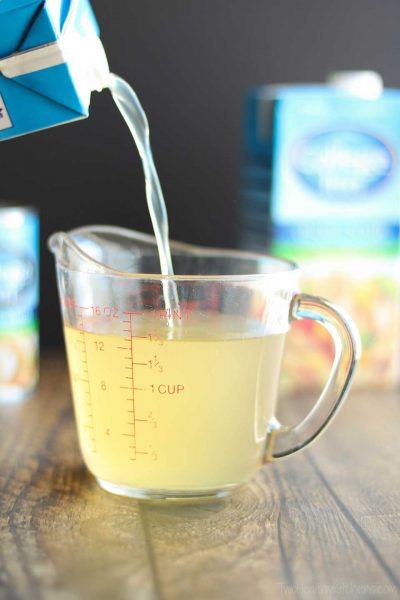

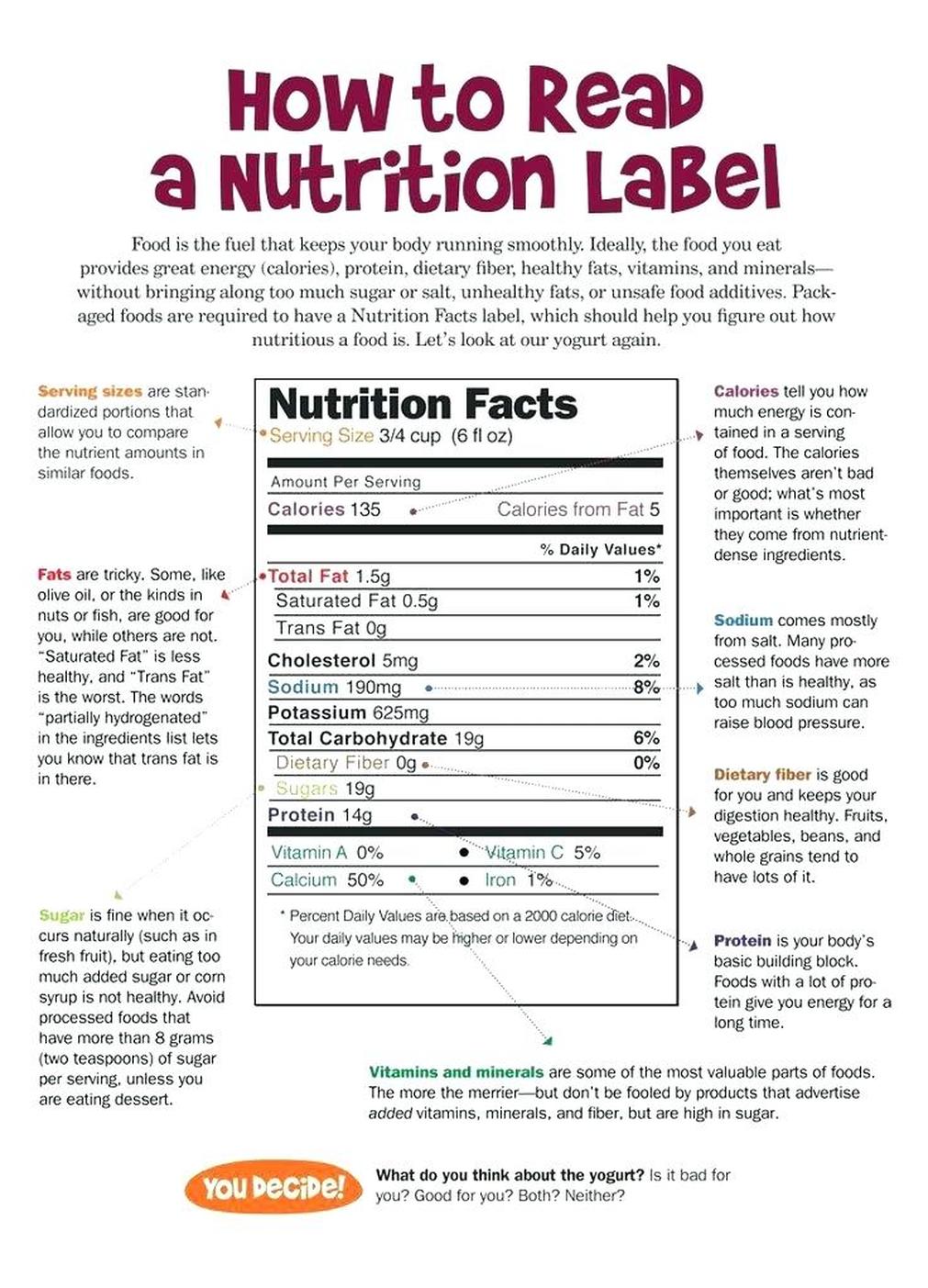
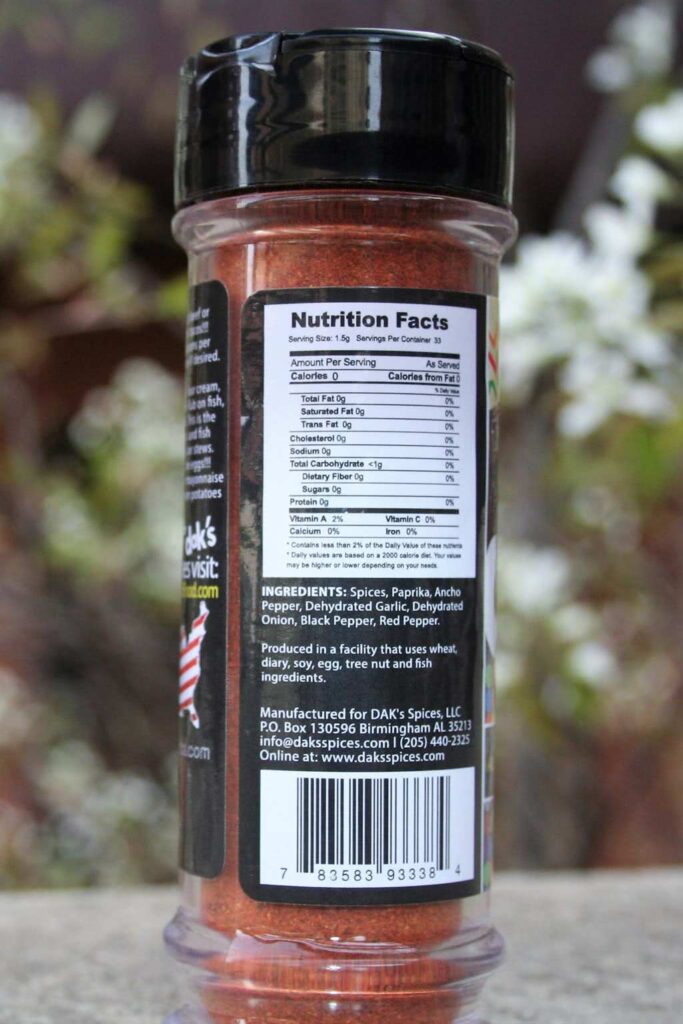
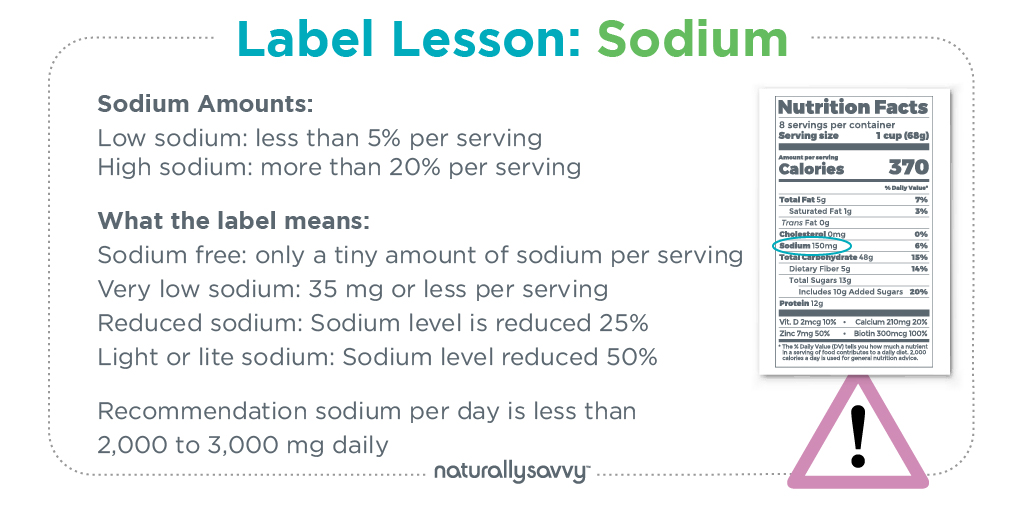

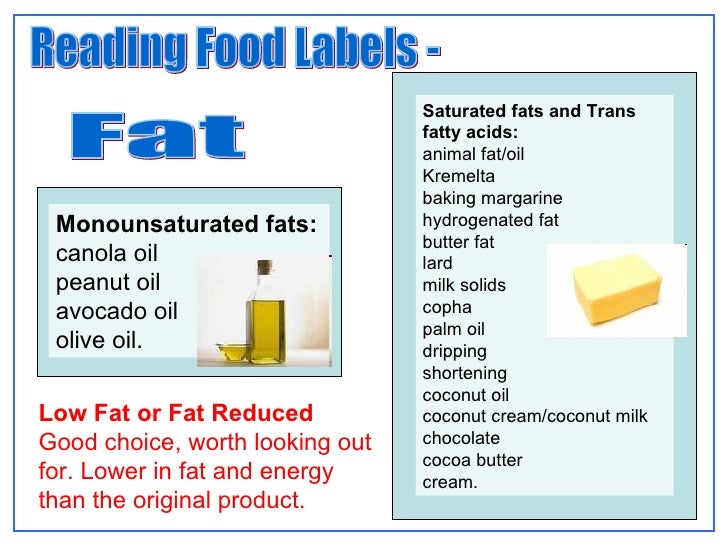

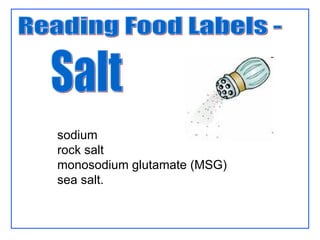
Post a Comment for "38 reading labels for sodium"